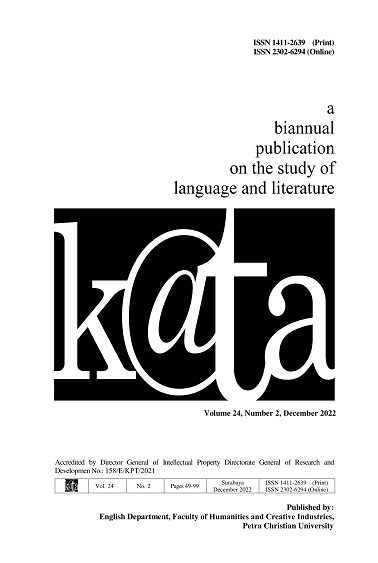Cultural Representation of Chinese-Indonesians in Ca Bau Kan (The Courtesan) in the Context of Spice Trading and Nationalism
Abstract
The object of this research is Nia Dinata’s film, Ca Bau Kan, which was adapted from Remy Sylado’s novel. The research focuses on the representation of Chinese-Indonesians which pertains to the context of the maritime spice trade route and the concept of nationalism. Set in Batavia in three different decades, namely the 1930s, 1940s, and 1960s, the film depicts the journey of a Chinese-Indonesian character from the Dutch colonial era and the Japanese colonial era to the era of the independence revolution. The research method used is a qualitative method through the theory of film studies, which is juxtaposed with the historical approach to see how Chinese-Indonesians are represented in the film. The findings show that the film attempts to represent the Chinese-Indonesians accurately, albeit with the continuous presence of inaccurate stereotypes. The findings show Chinese-Indonesians’ economic contribution that reflects the history of the spice trade maritime route in Indonesia.
Downloads
References
Botara, S. J. (2015). (Ber) - Teologi dari Film Ca Bau Kan. KENOSIS: JURNAL KAJIAN TEOLOGI, 1(1), 129–147. https://e-journal.iaknambon.ac.id/index.php/KNS/article/view/25/17
Britto, J. de. (2020). Inilah Marga-marga Tionghoa di Indonesia dan Nama-nama Tionghoa yang Di-Indonesia-kan. Kalderanews. https://www.kalderanews.com/2020/10/inilah-marga-marga-tionghoa-di-indonesia-dan-nama-nama-tionghoa-yang-di-indonesia-kan/
Chang, S. (2020). Chinese Women, Marriage and Gender: exploring the idea of women and marriage over time in the context of China. University of Windsor.
Dahana, A. (2000). Kegiatan awal Masyarakat Tionghoa di Indonesia. Wacana, Journal of the Humanities of Indonesia, 2(1), 54–72. http://journal.ui.ac.id/index.php/wacana/article/view/3848
Dinata, N. (2002). Ca Bau Kan. Kalyana Shira Film.
Erkelens, M. (2013). The Decline of The Chinese Council of Batavia: The Loss of Prestige and Authority of The Traditional Elite Amongst the Chinese Community from The End of The Nineteenth Century Until 1942 [Leiden University]. https://hdl.handle.net/1887/21954
Fatimah, T. (2014). The History of Pancoran-Glodok Chinatown in the Context of Urban Kampong Locality in Jakarta. In T. J. Daryanto & E. Herlian (Eds.), Membangun Karakter Kota Berbasis Lokalitas (pp. 118–129). Jurusan Arsitektur Fakultas Teknik Universitas Sebelas Maret. https://www.academia.edu/44082894/SEJARAH_KAWASAN_PECINAN_PANCORAN_GLODOK_DALAM_KONTEKS_LOKALITAS_KAMPUNG_KOTA_JAKARTA_The_History_of_Pancoran_Glodok_Chinatown_in_the_Context_of_Urban_Kampong_Locality_in_Jakarta
Gultom, A. (2018). Kalapa – Jacatra –Batavia - Jakarta: An old city that never gets old. Spafa Journal: Journal of Archaeology and Fine Arts in Southeast Asia, 2, 1–27. https://doi.org/10.26721/spafajournal.v2i0.173 Authors:
Hapsari, R. D. (2016). Bibit Nasionalisme di Kalangan Penduduk Tionghoa di Indonesia. Jurnal Politica, 7(2), 255–270. https://doi.org/10.22212/jp.v7i2.1137
Hendiawan, T., & Rahmansyah, A. (2019). Landscape As Cultural Identity In Cau Bau Kan Movie. Balong International Journal of Design, 2(2). https://doi.org/https://doi.org/10.25134/balong.v2i2.2423
Herleni, S. (2018). Sikap Hidup Peranakan Tionghoa dalam Novel Ca Bau Kan Karya Remy Sylado. Madah Jurnal Bahasa Dan Sastra, 8(2), 177–184. https://doi.org/10.26499/madah.v8i2.639
Kiernan, M. (1990). Making Films Politically: Marxism in Eisenstein and Godard. Alif: Journal of Comparative Poetics, 10, 93–113. https://doi.org/https://doi.org/10.2307/521719
Lie, S., & Bailey, B. (2017). The power of names in a Chinese Indonesian family’s negotiations of politics, culture, and identities. Journal of International and Intercultural Communication, 10(1), 80–95. https://doi.org/https://doi.org/10.1080/17513057.2016.1216577
Matanasi, P. (2017). Serba-Serbi Glodok, Kawasan Pecinan Sejak Masa VOC Baca selengkapnya di artikel “Serba-Serbi Glodok, Kawasan Pecinan Sejak Masa VOCâ€, https://tirto.id/ctUH. Tirto.Id. https://tirto.id/serba-serbi-glodok-kawasan-pecinan-sejak-masa-voc-ctUH
Meutia, F. S. (2017). Membaca “Tinung†dalam Film Ca Bau Kan: Analisis Wacana Kritis dalam Perspektif Gender. Jurnal Dakwah Tabligh, 18(1), 1–14. https://doi.org/https://doi.org/10.24252/jdt.v18i1.2946
Permanasari, E., & Lientino, T. (2018). Transformasi Makna dan Fungsi Ruang di RPTRA Kalijodo dalam Pergulatan Citra Kota Jakarta. Jurnal Ruas, 16(2), 13–27. https://doi.org/http://dx.doi.org/10.21776/ub.ruas.2018.016.02.2
Poelinggomang, E. (2016). Jaringan Perdagangan Rempah-rempah. Konferensi Nasional Sejarah X: Budaya Bahari Dan Dinamika Kehidupan Bangsa Dalam Perspektif Sejarah.
Raditiyanto, S. (2018). Ca Bau Kan dan Sejarah Prostitusi Batavia: Kajian Pendekatan Semiotika Inertekstual (Non Fiksi). Ensains Journal, 1(1), 20–25. https://doi.org/https://doi.org/10.31848/ensains.v1i1.55
Sabakti, S. (2013). Struktur Narasi Novel Ca Bau Kan, Karya Remy Sylado Analisis Semiotik. Madah Jurnal Bahasa Dan Sastra, 4(1), 70–81. https://doi.org/10.26499/madah.v4i1.557
Sholehuddin, M. (2013). Kajian Antropologi Sastra Dan Nilai Pendidikan Novel Ca Bau Kan Karya Remy Sylado [Universitas Sebelas Maret]. https://digilib.uns.ac.id/dokumen/detail/30422/Kajian-Antropologi-Sastra-Dan-Nilai-Pendidikan-Novel-Ca-Bau-Kan-Karya-Remy-Sylado
Simatupang, S. (2017). Proses Sosial dalam Produksi Ruang Publik “RPTRA†Kalijodo di Jakarta. Jurnal Arsitektur Scale, 5(1), 43–55. http://repository.uki.ac.id/188/1/PROSES SOSIAL DALAM PRODUKSI RUANG PUBLIK ‘RPTRA’ KALIJODO DI JAKARTA.pdf
Sulistiyono, S. T. (2016). Jawa Dan Jaringan Perdagangan Maritim Di Nusantara Pada Periode Awal Modern. Konfrensi Nasional Sejarah X Jilid I.
Sutandio, A. (2014). Ca Bau Kan: The Problematic Centralizing of the Marginalized. Aurora, 1(4), 263–374. http://repository.maranatha.edu/19466/
Sutandio, A. (2019). Cinematic Representation of Chinese-Indonesians’ Trauma in Jason Iskandar The Day The Sky Roared. Lingua Cultura, 13(4), 275–281. https://doi.org/https://doi.org/10.21512/lc.v13i4.6000
Tobing, R. (2017). Wajah Jakarta Kala Pelayanan Publik Berfungsi. Kompasiana.Com. https://www.kompasiana.com/rinsanlumbantobing/58aed58bb17a612f09c16d66/wajah-jakarta-kala-pelayanan-publik-berfungsi
Urban, G. S. (2013). The Eternal Newcomer: Chinese Indonesian Identity from Indonesia to the United States. LUX: A Journal of Transdisciplinary Writing and Research from Claremont Graduate University, 3(1), 1–11. https://core.ac.uk/download/pdf/148358318.pdf
Utama, W. S. (2012). Kehidupan Sosial-Budaya Masyarakat Tionghoa di Batavia 1900an-1930an. Jurnal Lembaran Sejarah, 9(1), 19–38. https://jurnal.ugm.ac.id/lembaran-sejarah/article/download/23765/15646.
Wibowo, G. A. (2015). Kuli Cina di Perkebunan Tembakau Sumatra Timur Abad 18. SEUNEUBOK LADA: Jurnal Ilmu-Ilmu Sejarah, Sosial, Budaya Dan Kependidikan, 2(2), 51–67. https://ejurnalunsam.id/index.php/jsnbl/article/view/567/465
Yuwanto, Y. (2012). Politics of National Identity: Comparative Analysis on Indonesia and South Korea. Politika: Jurnal Ilmu Politik, 3(1), 117–122. https://doi.org/https://doi.org/10.14710/politika.3.1.2012.117-122

This work is licensed under a Creative Commons Attribution 4.0 International License.
![]() This work is licensed under a Creative Commons Attribution License
This work is licensed under a Creative Commons Attribution License




.png)
.png)

.png)












